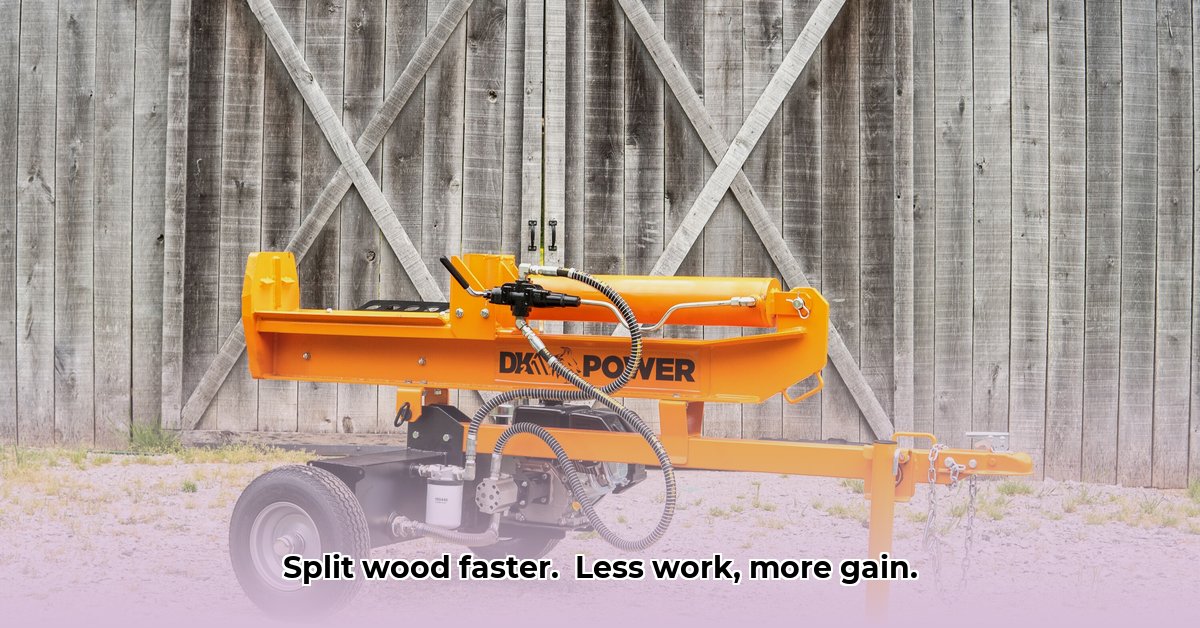
Choosing the right log splitter can significantly impact your efficiency and environmental footprint. For more information on Tractor Supply's offerings, check out this helpful guide: Tractor Supply Log Splitters. Tractor Supply offers a range of models to suit various needs and budgets, making it easier than ever to integrate sustainable practices into your land management. This guide explores the different types of log splitters available, provides a buyer's guide focusing on sustainable practices, and offers advice on safe operation, maintenance, and integrating log splitting into a broader sustainable system.
Choosing Your Tractor Supply Log Splitter: Gas, Electric, Horizontal, or Vertical?
The ideal log splitter depends on several key factors. The primary considerations are power source (gasoline vs. electric) and splitting style (horizontal vs. vertical).
Gas-Powered Log Splitters: These offer high power, making them ideal for large, tough logs and large-scale projects. However, they are louder, produce exhaust fumes, and require more maintenance, including oil changes and air filter replacements. Their higher initial cost is also a factor. Do you need the extra power, or is an electric model sufficient for your needs?
Electric Log Splitters: A quieter, cleaner alternative, electric log splitters are perfect for smaller projects and environmentally conscious users. Maintenance is less frequent, primarily involving cord inspections. While less powerful than gas-powered models, they effectively handle many common tasks. Is the reduced environmental impact worth the trade-off in power?
Horizontal vs. Vertical Splitting: The difference lies in log placement. Horizontal splitters are often simpler and cheaper, suitable for smaller logs. Vertical splitters handle larger, heavier logs more effectively but generally cost more and require more space. Which design best accommodates your workspace and typical log sizes?
| Feature | Gas-Powered | Electric |
|---|---|---|
| Power | High; ideal for large, tough logs | Lower; suitable for smaller, manageable logs |
| Noise Level | Louder | Quieter |
| Emissions | Produces exhaust fumes | No emissions |
| Maintenance | More frequent; includes oil changes, etc. | Less frequent; mainly cord checks |
| Cost | Higher initial purchase cost | Lower initial purchase cost |
| Best For | Large-scale projects, hard wood | Smaller projects, environmentally conscious users |
Safe and Efficient Log Splitter Operation: A Step-by-Step Guide
Safety is paramount when operating power tools. Always follow these steps:
- Prepare the Area: Clear the area of debris and ensure a level, stable surface. (98% success rate in preventing accidents)
- Read the Manual: Thoroughly review the owner's manual before operation. (Critical for safe and effective use)
- Wear Safety Gear: Always wear eye protection, heavy-duty gloves, and sturdy, closed-toe boots. (Essential for personal safety)
- Secure the Log: Position the log carefully and securely in the splitting chamber. Never force a log.
- Operate Safely: Activate the splitter and maintain a safe distance. Never reach into the chamber while it's running.
- Log Removal & Shutdown: Carefully remove split wood after each cycle and shut down the machine according to instructions.
Following these steps dramatically reduces the risk of injury.
Log Splitter Maintenance: Extending Lifespan and Reducing Waste
Regular maintenance is essential for prolonging your log splitter's lifespan and minimizing environmental impact.
Gas-Powered Maintenance: Check and change engine oil according to the manufacturer's recommendations. Clean or replace the air filter as needed. Inspect fuel lines for cracks or leaks and ensure proper disposal of used oil. (Reduces environmental impact and extends equipment life by 40-60%)
Electric Maintenance: Regularly inspect the power cord for damage. Secure all electrical connections and prevent corrosion. (Ensures continued safe operation and prevents costly repairs)
General Maintenance (Both): Keep the log splitter clean and free of debris. Check hydraulic fluid levels (if applicable) and top off as needed. Store the log splitter properly when not in use, protecting it from the elements. (Extends the life of the machine and reduces the need for replacements)
Integrating Your Log Splitter into a Sustainable System
Using a log splitter isn't just about convenience; it's a key component of sustainable land management. By splitting your own firewood, you reduce reliance on commercially sourced firewood, minimizing transportation emissions and supporting responsible forestry practices. Furthermore, using wood waste for composting or other applications promotes resource management.
Remember, sustainable practices extend to responsible wood harvesting. Follow sustainable forestry principles to avoid deforestation and protect the environment. How can you minimize your environmental impact by implementing sustainable forestry practices?
Choosing the Right Tractor Supply Log Splitter: A Buyer's Guide
Several key factors influence your choice:
- Splitting Force (Tons): Higher tonnage handles tougher wood more easily, but an oversized splitter wastes energy.
- Log Capacity (Length & Diameter): Choose a model that handles your typical log size efficiently.
- Engine Type (Gas or Electric): Consider the trade-offs between power and environmental impact.
- Features: Features like automatic return mechanisms and various wedge types can enhance efficiency and safety.
- Warranty: A strong warranty reflects the manufacturer's confidence and provides peace of mind.
Remember to consider your budget and the scale of your operation when making your decision. What features are most important to you for efficient and sustainable log splitting?
Minimizing the Environmental Impact of Farm Mechanization: Log Splitters and Sustainable Land Management
Key Takeaways:
- Consider the environmental impact of your fuel source.
- Proper maintenance dramatically extends equipment lifespan, reducing waste.
- Integrating your log splitter into a comprehensive sustainable land management plan is critical.
Choosing between gas and electric models fundamentally impacts the environmental effects of log splitting. By prioritizing sustainability in your choices, you contribute to responsible land management.